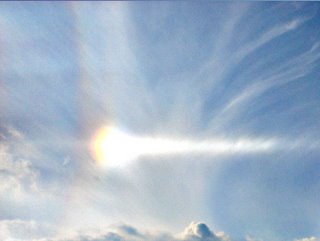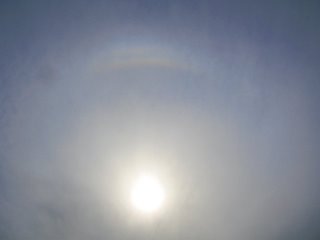Showing posts with label circular Lowitz arc. Show all posts
Showing posts with label circular Lowitz arc. Show all posts
Sunday, 12 February 2017
Fine Lowitz arcs in lunar diamond dust display
Vesa Korhonen photographed this lunar display in Hämeenkyrö in the evening of 10 February at 2038 local time. The circular Lowitz arcs are splendid. The upper and lower components are expected to accompany, and seem to be there, but are rather overwhelmed by the intense 22° halo.
Tuesday, 7 February 2017
Lowitz - the new normal?
In 2017, halo activity in my part of the United Kingdom has so far been very quiet with not much to get excited about apart from the occasional odd radius lunar halo. However, on the 6th February things improved a little with a nice little display which included 22°, both parhelia (sporting parhelic tails), uta, possible Parry, cza, supralateral and all three Lowitz variants. The upper and lower Lowitz were vestigial, but the middle Lowitz illustrated here was quite clearly defined.
This burst of activity got me ruminating about the frequency of certain types of halos and the nature of “rarity”. Compared to many of you 'old hands', I am a comparative newcomer to halo observation. When I first started to observe, many halos were still considered to be extreme rarities or at least exceptionally infrequent. Others, such as the Kern, were so rare that they were considered to be the Holy Grail of halos, so few were their sightings. What I have noticed over the last few years is that many of these rarities are seemingly becoming far more frequent and in my own mind at least, I have downgraded them from ‘rare’ to ‘infrequent’.
Take the Lowitz arc for example. It is only a few short years ago that its very existence was being doubted, controversial to say the least. First, there were a few sightings, then a trickle of photographic images emerged which confirmed it as a reality. Over the past ten years, their frequency has seemingly increased to the point where I will see several per year and look out for them as a matter of course. Whilst not commonplace, they are certainly hovering somewhere in that vague, nebulous no-man’s land between infrequent and relatively frequent. Likewise, the Kern. At first a mythical creature, but now we are seeing the first drips which will eventually become a trickle….
So what has caused this apparent change in frequency, this downgrading of status? I would like to posit two possible causes: the ubiquity of digital imaging and advances in image processing. It is not that these halos are actually becoming more frequent in reality but that the effect of digital imaging and the development of image processing techniques are revealing them to be present in many more displays than were hitherto thought. In the past, one would take a roll of traditional film, but prior to image processing what did one do with them? Answer, nothing in most cases. You either saw the halo on a particular frame or you didn’t. This resulted in some of these rare halos only showing themselves under exceptional conditions. With the advent of inexpensive digital cameras and image processing software we saw far more phenomena being recorded. However, it is only with the introduction of the B-R processing technique pioneered by Nicolas Rossetto and perfected by Nicolas Lefaudeux and to a lesser extent image stacking, do we really notice an apparent increase in all types of rare halos. These techniques alone have been responsible for the massive increase of rare halo frequency and the identification of several new halo species. We have now reached a point where what was new and exciting yesterday, is passé today.
I think this trend is going to continue as more and more observers embrace these new methods of working. We have already seen it occur in the wider field of atmospheric optics where photographic identification of higher order rainbows, especially the third and fourth orders, are now becoming a reality. One might argue where is the hard evidence to prove this is anything but a theory or personal opinion? This evidence is indeed hard to come by, however projects such as Lefaudeux's 'HaloCam' has demonstrated without a shadow of a doubt that certain halos are far more frequent than previously thought. For example, he has very clearly demonstrated that the 46° halo is present almost as often as the 22°, whereas at one time it was considered to be a very infrequent visitor to the skies. So not only will this trend continue, I think it will also accelerate, especially in the field of spotlight displays where new halos are being discovered on a very regular basis. Even in daylight displays, new halos are still being captured from time to time using these techniques.
A few years ago, it seemed like everything that could be seen had been seen. We are now on the cusp of a new era of halo research. Today may indeed be considered passé by some, but tomorrow is definitely going to be tremendously exciting! I want to be a part of that new wave of discovery.
Alec Jones
Labels:
22° halo,
46° halo,
circular Lowitz arc,
circumzenithal arc,
Kern arc,
lower Lowitz arc,
Lowitz arc,
middle Lowitz arc,
parhelia,
parhelic tail,
supralateral arc,
upper Lowitz arc,
upper tangent arc
Friday, 3 November 2006
Diamond dust season opened in Finland
On October 26 the pupils of the Särkijärvi school near the small northern Finland town of Muonio stopped suddenly their indoor activities and rushed out - somebody had noticed a halo wonder in the sky.
At the school were also excursionists from University of Lapland. Among them, Päivi Linnansaari happened to have a camera handy and took several photos of which a selection is presented here.
The display had all the basic flavourings of a great diamond dust display, including the helic arc, circular Lowitz arc and diffuse anthelic arc - the latter of which is seen faintly in the lower left image. But then there is also a new halo: the 46° contact arcs. Theoretically it has been known for quite a while, but no convincing photographs have come up untill now. The halo shows up in the upper right image as three arcs below the circumzenith arc. Probably a comparison with simulation is needed to get a proper grip of it.
The halo display made it also to local newspaper. Couple of kilometres from the location there is a ski center, so the halos may likely have originated from snow guns.
Sunday, 15 October 2006
Unidentified halo display in Romania
Attila Kosa-Kiss from Salonta, Romania observed on 29th September 2006 a very interesting halo display at a sun elevation of 12°. Unfortunately, there were no photos but there is a sketch. The most probable explanation is the existence of suncave [H] and sunvex [G] Parry arcs, as shown by the simulation from Les Cowley. Other possibilities would be an circular Lowitz arc [F], as seen on the simulation with HALOET (random: 0.5, plates: 0.5, columns: 0.5, parry: 0.5, Lowitz: 4.0, number of rays=150000). On the same day was observed several time in Germany and Czech the upper part of Lowitz arcs. But Romania was influenced by another weather front (with another cirrus clouds) like the middle European area. Further comments and ideas are very welcome!
by Claudia Hinz
Saturday, 14 October 2006
Czechoslovakia Lowitz arcs
This photo show nice circular Lowitz arc. Photo was taken by Michal Nagy from Slovakia at September 29 2006. My photo possible all components of Lowitz arcs was taken in Holesov (Czech rep.) at October 12 2006.
Saturday, 13 May 2006
Doubled Halos?
This image was taken in Fukushima pref. in Japan, by Mr. Tasan (handle), May 5, 2006. There are two halos -- the lower one seems a 22 degree halo, but what is the upper one? I think it can be a 24 (or 23?) degree halo, a circular Lowitz arc or a 23 degree plate arc. What are your opinions?
Subscribe to:
Posts (Atom)





